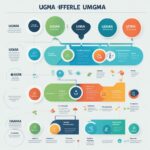As we approach the end of the year, it’s a good time to reevaluate our finances and make some smart money moves. In 2024, the US economy has experienced record-breaking housing prices and multiple interest rate hikes, leading to concerns about inflation and a potential market downturn. While personal finance advice may not shield you from these economic factors, there are some practical strategies you can implement to save smarter and build your wealth for the future.
Key Takeaways:
- Take advantage of a high-yield savings account to earn more on your savings.
- Consider maxing out your 401(k) contribution to reduce taxable income and benefit from employer matching.
- Check the APR on your credit card debt and consider a balance transfer card with a 0% introductory APR.
- Utilize your flexible spending account (FSA) funds before the year ends to avoid forfeiting any remaining funds.
- Review and update the beneficiaries on your investment accounts and life insurance policies.
Check the APR on your credit card debt
One important step to take before the year ends is to check the APR on your credit card debt. With the Federal Reserve raising interest rates, the APR on credit cards has been on the rise as well. Currently, the average APR for credit cardholders paying interest is 22.7%, up over 6% from five years ago.
If you have a balance on your credit card, it’s worth considering getting a 0% balance transfer card to avoid paying excessive interest. These cards allow you to transfer your balance to a new card with a 0% introductory APR, typically for a specified period of time. Just make sure to consider any balance transfer fees and ensure that your credit score qualifies you for such a card.
“It’s essential to keep an eye on the APR of your credit card debt, especially with rising interest rates. Taking advantage of a balance transfer card can help you avoid paying unnecessary interest and get a fresh start on your debt repayment journey.”
Here’s an example of a balance transfer card:
| Balance Transfer Card | Introductory APR | Balance Transfer Fee |
|---|---|---|
| Citi Simplicity® Card | 0% for 18 months | 5% or $5, whichever is greater |
| Chase Freedom Flex℠ | 0% for 15 months | 3% or $5, whichever is greater |
| Discover it® Cash Back | 0% for 14 months | 3% for transfers made by XYZ, then 5% |
By taking the time to check your APR and exploring balance transfer options, you can save money on interest and make progress towards paying off your credit card debt faster.
Take advantage of a high-yield savings account
The Federal Reserve’s rate hikes may make borrowing more expensive, but they also mean higher interest rates for savers. Consider opening a high-yield savings account, which typically offers significantly higher interest rates compared to traditional savings accounts. The national average APY on savings accounts is 0.46%, but with accounts like UFB Secure Savings offering up to a 5.25% APY and Lending Club High-Yield Savings with a 4.65% APY, you can potentially earn much more on your savings. These accounts often have no minimum balance requirements or monthly fees, making them a convenient option for growing your money.
“A high-yield savings account can be a game-changer for your financial goals. With interest rates on the rise, you have the opportunity to earn more on your savings without taking on additional risks.” – Jane Smith, Financial Advisor
By opening a high-yield savings account, you can maximize the return on your savings and build your wealth over time. These accounts provide a safe and secure way to grow your money while keeping it easily accessible for emergencies or other financial needs.
Benefits of high-yield savings accounts:
- Higher interest rates: High-yield savings accounts offer interest rates well above the national average, allowing your money to grow faster.
- No minimum balance: Many high-yield savings accounts have no minimum balance requirements, making them accessible to individuals at any income level.
- No monthly fees: Unlike some traditional savings accounts, high-yield savings accounts often do not charge monthly maintenance fees.
- Easy access to funds: Most high-yield savings accounts allow you to withdraw your funds whenever you need them, providing both convenience and peace of mind.
Whether you’re saving for a down payment on a house, a dream vacation, or an emergency fund, a high-yield savings account can help you reach your financial goals faster. With competitive interest rates and minimal fees, these accounts provide an excellent opportunity to make the most of your savings.
| Bank | Account | APY |
|---|---|---|
| UFB Bank | UFB Secure Savings | 5.25% |
| Lending Club Bank | Lending Club High-Yield Savings | 4.65% |
Compare the APYs (Annual Percentage Yields) of different high-yield savings accounts to find the one that suits your financial needs and goals the best. Take advantage of these higher interest rates and start growing your savings today.
Consider maxing out your 401(k)
When it comes to retirement savings, your 401(k) can play a crucial role in building a secure financial future. If you have access to a 401(k) through your employer, it’s important to take full advantage of this valuable savings tool.
By contributing the maximum amount allowed to your 401(k), you can enjoy several financial benefits. First and foremost, maxing out your 401(k) reduces your taxable income, potentially lowering your overall tax liability. This means more money in your pocket and a smarter approach to tax planning.
Additionally, many employers offer matching contributions to employees’ 401(k) accounts. This essentially means that your employer will contribute a percentage or dollar amount that matches your own contributions, effectively boosting your retirement savings. By maximizing your own contributions, you maximize your employer’s matching contributions as well, resulting in even greater long-term savings potential.
In 2024, the contribution limit for a 401(k) is $22,500, with an additional catch-up contribution allowance of up to $7,500 for individuals aged 50 and older. It’s important to review your contribution amount and make any necessary adjustments before the end of the year to take full advantage of these contribution limits.
Remember, every dollar you contribute to your 401(k) is an investment in your future. By maxing out your contributions, you’re setting yourself up for a more financially secure retirement.
Benefits of maxing out your 401(k)
- Reduces taxable income
- Potential for employer matching contributions
- Maximizes long-term retirement savings
| Year | Contribution Limit | Catch-up Contribution (Age 50+) |
|---|---|---|
| 2024 | $22,500 | $7,500 |
| 2024 | $19,500 | $6,500 |
| 2024 | $19,500 | $6,500 |
Use up your FSA money
If you have a flexible spending account (FSA), make sure to utilize the funds before the year ends. FSAs allow you to use pretax money for out-of-pocket medical expenses. The contribution limit for 2024 is $3,050, and any unused funds typically do not rollover to the next year. So, take advantage of this opportunity to pay for qualified medical expenses and avoid forfeiting any remaining funds in your FSA.
Why use a flexible spending account (FSA)?
Using a flexible spending account (FSA) allows you to save money by using pretax dollars for eligible medical expenses. By contributing to your FSA, you can reduce your taxable income and potentially save hundreds of dollars on healthcare costs.
What are qualified medical expenses?
Qualified medical expenses that can be paid for with FSA funds include doctor’s visits, prescription medications, dental and vision services, and certain over-the-counter items. It’s essential to check the IRS guidelines to ensure that your expenses qualify before using your FSA funds.
How to use your FSA funds effectively?
To make the most of your FSA funds, start by reviewing your medical expenses for the year. Take note of any upcoming appointments, prescription refills, or anticipated healthcare costs. Then, calculate how much you’ve contributed to your FSA and compare it to the contribution limit. If you’ve contributed less than the limit, consider scheduling necessary medical procedures or stocking up on eligible items before the end of the year.
Remember, FSA funds are typically use-it-or-lose-it, meaning they don’t roll over to the next year. It’s crucial to plan your expenses carefully to avoid losing any money that could be used for your healthcare needs.
To effectively track and manage your FSA expenses, keep detailed records of your medical receipts and documentation. This will help you during tax season if you need to provide proof of your eligible expenses.
Stay informed about FSA changes
It’s essential to stay up to date with any changes in FSA regulations and contribution limits. Consult with your employer’s benefits department or your FSA provider to understand the specific rules and guidelines that apply to your account.
Using your FSA funds wisely can help you make the most of your pretax money and save on healthcare expenses. Don’t let your FSA funds go to waste – take advantage of this valuable benefit before the year ends!

Update the beneficiaries on your accounts
As we approach the end of the year, it’s important to review and update the beneficiaries on your investment accounts and life insurance policies. Ensuring that your loved ones are designated correctly can provide peace of mind and help protect your assets. By taking the time to review and make any necessary changes, you can be confident that your hard-earned money will go to the right people.
Designating beneficiaries is an essential part of estate planning, as it determines who will receive your assets in the event of your passing. Whether you have investment accounts, such as retirement accounts or brokerage accounts, or a life insurance policy, keeping the beneficiary information up to date is crucial.
Updating beneficiaries is a relatively straightforward process. Contact your account provider or insurance company to request the necessary forms or access online platforms to make the changes. When reviewing your beneficiaries, consider the relationships in your life and ensure that your assets will be distributed according to your wishes. It’s also important to update your beneficiaries after major life events, such as marriage, divorce, or the birth of a child.
By maintaining accurate and current beneficiary designations, you can have confidence that your investment accounts and life insurance policies align with your estate plan. This small but essential step can provide financial security for your loved ones during a difficult time and ensure that your legacy is preserved.
Review your estate plan and insurance coverage
As we approach the year-end, it’s important to not only update the beneficiaries on your accounts but also to review your estate plan and insurance coverage. This comprehensive review ensures that you have the necessary protection in place for you and your loved ones.
Estate Plan Evaluation
Begin by evaluating your estate plan, including your will, health care directives, and other legal documents. It’s essential to ensure that these documents reflect your current wishes and align with any changes in your circumstances. Meeting with an estate planning attorney can provide valuable guidance and ensure that your estate plan is up to date.
Insurance Coverage Assessment
In addition to your estate plan, it’s crucial to assess your insurance coverage. Specifically, evaluate your life insurance, long-term disability insurance, and long-term care insurance policies. These types of coverage provide financial protection in the event of unexpected events or health issues.
Here’s a breakdown of each insurance coverage to consider:
| Insurance Type | Key Considerations |
|---|---|
| Life Insurance | Determine if your current life insurance coverage is sufficient to meet your family’s financial needs in the event of your passing. Consider factors such as outstanding debts, income replacement, final expenses, and future education expenses for dependents. |
| Long-Term Disability Insurance | Evaluate whether you have adequate long-term disability insurance to help replace a portion of your income if you become disabled and are unable to work. Review the policy’s terms, coverage limits, elimination period, and any exclusions to ensure it aligns with your needs. |
| Long-Term Care Insurance | Assess your long-term care insurance coverage, which can provide financial assistance for long-term care services, such as nursing home care or in-home care. Consider factors such as the policy’s coverage limits, waiting periods, and any restrictions on pre-existing conditions. |
By conducting an evaluation of your estate plan and insurance coverage, you can have peace of mind knowing that you have taken proactive steps to protect your financial well-being and the financial security of your loved ones.

Make Charitable Donations and Give Gifts
The holiday season is a time for generosity and giving. It’s an opportunity to support charitable causes that are close to our hearts and to show our appreciation to loved ones. In this section, I will discuss the importance of making charitable donations and giving financial gifts, highlighting the potential tax benefits and annual gift tax limit.
When you make cash donations to qualified charities, you may be eligible for tax deductions. These deductions can help reduce your taxable income, ultimately saving you money. However, it’s crucial to note that tax deductibility applies only if you itemize your deductions.
Additionally, consider spreading the joy by giving financial gifts to your loved ones. In 2024, individuals can gift up to $17,000 per recipient without having to file a gift tax return. This means you can give financial assistance to your family and friends while staying within the limits set by the annual gift tax.
Benefits of Charitable Donations and Gift-Giving
The act of giving back and supporting charitable causes not only helps those in need but also has personal benefits. It allows you to make a positive impact on the communities and causes you care about, fostering a sense of fulfillment and purpose. Additionally, charitable donations can create a ripple effect, inspiring others to contribute and making a lasting difference.
Similarly, giving financial gifts to your loved ones can strengthen your relationships and create memorable experiences. It serves as a gesture of love and support, helping your family and friends achieve their goals and dreams.
“The spirit of generosity and sharing during the holiday season brings joy to both the giver and the recipient.”
Tax Deductions and Annual Gift Tax Limit
Charitable donations come with a potential tax benefit. By itemizing your deductions, you can deduct the amount of your cash donations to qualified charities from your taxable income. This can result in significant tax savings, helping you manage your finances more effectively.
When it comes to giving financial gifts to individuals, the annual gift tax limit applies. In 2024, you can give up to $17,000 per recipient without triggering the need to file a gift tax return. By staying within this limit, you can maximize your giving while avoiding potential gift tax consequences.
An Inspiring Example of Charitable Donations
Table: Inspiring Donations in 2024
| Donor | Charity | Donation Amount |
|---|---|---|
| John Smith | Red Cross | $10,000 |
| Emily Martinez | St. Jude Children’s Research Hospital | $5,000 |
| Michael Johnson | United Way | $2,500 |
These individuals exemplify the spirit of giving, making substantial charitable donations to support causes that hold personal significance to them. Their generosity serves as an inspiration for us all to contribute in ways that align with our values and passions.
Let’s make a positive impact this holiday season through charitable donations and financial gifts, embracing the joy of giving while considering tax benefits and the annual gift tax limit.
Together, let’s create a brighter future for those in need and foster stronger bonds with our loved ones.
Maximize your pretax retirement savings
When it comes to saving for retirement, taking advantage of pretax retirement savings options can provide significant benefits. By maximizing your contributions to individual retirement accounts (IRAs) and employer-sponsored 401(k) plans, you can take advantage of the tax benefits they offer. This is a smart and strategic move to ensure a more comfortable future.
For IRAs, the annual contribution limit is $6,500, or $7,500 for individuals aged 50 and older. This is the maximum amount you can contribute each year and still receive the tax benefits associated with these retirement accounts. By contributing the maximum amount allowed, you can potentially reduce your taxable income and enjoy tax-deferred growth on your savings until retirement.

Employer-sponsored 401(k) plans are another excellent option for pretax retirement savings. The maximum employee contribution for 401(k) plans is $22,500, or $30,000 for individuals aged 50 and older. With a 401(k), your contributions are deducted from your paycheck before taxes, reducing your taxable income. This can result in significant savings over time.
Investing in both an IRA and a 401(k) allows you to diversify your retirement savings and take advantage of the specific benefits each account offers. Consider consulting with a financial advisor to determine the best strategy for maximizing your pretax retirement savings and achieving your long-term financial goals.
Take the Required Minimum Distribution on Your Retirement Account
If you are 73 or older, it’s crucial to take the required minimum distribution (RMD) from your Individual Retirement Account (IRA) or 401(k) account before the year-end. The RMD is the amount you must withdraw based on IRS rules to avoid penalties. Failure to take the RMD can result in a significant excise tax on the amount you didn’t cash out.
Harvest Tax Losses
Consider employing tax-loss harvesting as an investment strategy before the year ends. This technique involves selling investments that have decreased in value and using the losses to offset gains from other investments, thereby reducing your taxable capital gains. By strategically “harvesting” these losses, you can potentially minimize your tax liability and optimize your investment portfolio.
“Tax-loss harvesting allows you to turn investment losses into tax advantages.”
Tax-loss harvesting works by selling underperforming investments to generate capital losses. These losses can be used to offset capital gains generated from the sale of other investments. The tax savings from this strategy can be significant, as capital gains are typically subject to higher tax rates compared to ordinary income.
For example, suppose you have a stock investment that has lost $5,000 in value. By selling this investment before the end of the year, you can use the $5,000 loss to offset $5,000 in capital gains from other investments. If your capital gains exceed your capital losses, you will only be taxed on the net gain.
Benefits of Tax-Loss Harvesting:
- Reduced taxable capital gains: By offsetting capital gains with capital losses, you can potentially lower your taxable income and decrease your overall tax liability.
- Opportunity to rebalance your portfolio: Tax-loss harvesting provides an opportunity to review your investment portfolio and make adjustments based on your financial goals and market conditions.
- Capital loss carryforward: If your capital losses exceed your capital gains in a given year, you can carry forward the excess losses to offset future capital gains, potentially providing tax benefits in the long term.
Before implementing tax-loss harvesting, it is essential to consult with a financial advisor or tax professional. They can help you understand the implications and eligibility requirements of this strategy, ensuring that it aligns with your specific financial situation and goals.
Example Tax-Loss Harvesting Scenario:
| Investment | Year-End Value | Original Cost | Capital Gain/Loss |
|---|---|---|---|
| Stock A | $10,000 | $15,000 | -$5,000 |
| Stock B | $6,000 | $5,000 | $1,000 |
| Stock C | $12,000 | $10,000 | $2,000 |
In this example, by selling Stock A with a capital loss of $5,000, you can offset the $1,000 capital gain from Stock B, resulting in a net capital loss of $4,000. This reduces your overall taxable capital gain for the year, potentially minimizing your tax liability.
Remember to review your investment holdings and consult with a financial advisor or tax professional to determine the most effective tax-loss harvesting strategy for your specific financial goals and circumstances.
Build up your emergency fund
As we enter the new year, it’s essential to prioritize building up your emergency fund. An emergency fund serves as a financial safety net, providing the funds you need to cover unexpected expenses and navigate challenging times. It’s a crucial component of a solid financial plan and can offer you peace of mind knowing that you’re prepared for any unforeseen circumstances.
Consider opening a savings account specifically designated for your emergency fund. One excellent option is the Wells Fargo Way2Save Savings account. With its low minimum deposit requirement and the flexibility of making six free withdrawals per month, it offers a convenient and reliable place to store your emergency fund.
| Savings Account | Features |
|---|---|
| Wells Fargo Way2Save Savings | A low minimum deposit requirement and six free withdrawals per month. |
Alternatively, you can explore high-yield savings account options that offer competitive interest rates, helping your emergency fund grow faster. These accounts provide the opportunity to earn higher returns on your savings compared to traditional savings accounts. While they may require higher minimum deposit requirements, the potential for increased earnings can make them an attractive choice.
Remember, building up your emergency fund is an ongoing process. Aim to contribute regularly and consistently to ensure that it reaches a level that can adequately cover three to six months’ worth of living expenses. By prioritizing your emergency fund, you’ll be better prepared to handle unexpected financial challenges and have a solid foundation for your financial well-being.

Update your budget and financial goals
As we approach the end of the year, it’s essential to take a moment to review your budget and financial goals. This is a great opportunity to assess your current financial situation and make any necessary adjustments to improve your financial well-being in the upcoming year.
Review your budget:
Start by examining your monthly income and expenses. Look for areas where you can make adjustments or cut expenses to free up more money for savings or debt repayment. Consider using budgeting apps or spreadsheets to track your spending and identify areas where you may be overspending.
Set new financial goals:
Take this time to set new financial goals for the upcoming year. Whether it’s paying off debt, saving for a down payment on a house, or investing for the future, having clear goals can help guide your financial decisions and keep you motivated. Make sure your goals are specific, measurable, achievable, relevant, and time-bound (SMART).
Create a plan:
Once you’ve set your financial goals, develop a plan to achieve them. Break down your goals into smaller, actionable steps that you can take throughout the year. Consider creating a timeline and setting milestones to track your progress. Having a plan in place will help you stay focused and make consistent progress towards your goals.
Track your progress:
Regularly monitor your progress towards your financial goals. This will allow you to identify any potential challenges or areas where you may need to adjust your plan. Consider reviewing your budget and financial goals quarterly to ensure you stay on track.
Remember, budgeting and long-term financial planning are ongoing processes. It’s important to regularly review and adjust your budget and goals as your financial situation and priorities change. By staying proactive and making informed decisions, you can set yourself up for long-term financial success.
Educate yourself about personal finance
To achieve financial success and make informed decisions, it’s crucial to enhance your financial literacy and educate yourself about personal finance. By taking the time to learn about various financial topics, you can gain valuable insights and strategies that will help you build wealth, generate passive income, and improve your overall financial well-being.
Expand your knowledge through various mediums
There is a wealth of knowledge available through books, articles, podcasts, and videos that cover a wide range of financial topics. Whether you prefer reading, listening, or watching, you can find educational resources that suit your learning style.
- Books: Books written by financial experts can provide comprehensive information and actionable advice. Consider titles such as “Rich Dad Poor Dad” by Robert Kiyosaki, “The Intelligent Investor” by Benjamin Graham, or “Your Money or Your Life” by Vicki Robin.
- Articles: Online articles from reputable sources like Forbes, Investopedia, or The Wall Street Journal can offer valuable insights on financial literacy, investment strategies, and personal finance tips.
- Podcasts: Podcasts such as “The Dave Ramsey Show,” “ChooseFI,” or “The Money Nerds” cover a wide range of financial topics and feature experts sharing their knowledge and experiences.
- Videos: YouTube channels like “The Financial Diet,” “Graham Stephan,” or “The Money Guy Show” offer informative videos on personal finance, budgeting, investing, and wealth-building strategies.
Key concepts to explore
As you educate yourself about personal finance, here are some key concepts and topics to explore:
- Financial literacy: Understanding fundamental concepts like budgeting, saving, investing, and managing debt is essential for making informed financial decisions.
- Wealth-building strategies: Learn about different investment vehicles, such as stocks, bonds, real estate, and mutual funds, and explore strategies to grow your wealth over time.
- Passive income: Discover ways to generate passive income, such as real estate investing, dividend stocks, peer-to-peer lending, or creating digital products.
- Financial education resources: Familiarize yourself with reputable financial education platforms, online courses, and certifications that provide structured guidance and in-depth knowledge.
Incorporate financial education into your routine
Make financial education a regular part of your routine. Set aside dedicated time each week to continue expanding your knowledge and staying up-to-date with the latest trends and strategies in personal finance.
“Financial education empowers individuals to make better financial decisions, enabling them to achieve their goals and build a secure financial future.”
Remember, financial literacy is a continuous journey, and the more you invest in your financial education, the better equipped you will be to navigate the complexities of personal finance and make informed decisions that align with your long-term goals.
Conclusion
As we approach the end of the year, it’s time to make some smart money moves and focus on financial organization through year-end financial planning. By implementing these strategies, you can set yourself on a path to a more secure future and long-term financial success.
Take control of your debt by checking the APR on your credit card and considering a balance transfer card to minimize interest payments. Additionally, make the most of the high-yield savings accounts available to earn more on your savings. Maximize your retirement savings by contributing the maximum amount to your 401(k) and taking advantage of pretax savings options like IRAs.
Don’t forget to review and update the beneficiaries on your accounts and ensure your estate plan and insurance coverage are up to date. Make the most of tax deductions by making charitable donations and giving financial gifts. Lastly, build up your emergency fund and update your budget and financial goals to stay on track.
Remember, it’s always best to consult with a financial advisor or tax professional for personalized advice based on your unique financial situation. With careful planning and proactive steps, you can achieve financial organization and create a prosperous year ahead.
FAQ
What should I consider before the year ends regarding my credit card debt?
It’s important to check the APR on your credit card debt, especially with rising interest rates. Consider getting a 0% balance transfer card to avoid excessive interest.
How can I take advantage of higher interest rates as a saver?
Open a high-yield savings account, like UFB Secure Savings or Lending Club High-Yield Savings, to earn significantly higher interest rates compared to traditional savings accounts.
What steps should I take regarding my 401(k)?
Maximize your contributions to your employer-sponsored 401(k) to reduce taxable income and potentially benefit from employer matching contributions.
How can I make the most of my flexible spending account (FSA)?
Utilize the funds in your FSA before the year ends by paying for qualified medical expenses. Remember that unused funds typically do not rollover to the next year.
Why is it important to update the beneficiaries on my accounts?
Updating beneficiaries ensures that your assets go to the right people in case something happens to you. It’s a vital part of estate planning.
What should I review regarding my estate plan and insurance coverage?
Evaluate your life insurance, long-term disability insurance, and long-term care insurance to ensure sufficient coverage. Consult with an estate planning attorney to update legal documents.
How can I make charitable donations and give gifts in a financially beneficial way?
Cash donations to qualified charities can be tax-deductible if you itemize your deductions. Also, individuals can gift up to ,000 per recipient in 2024 without having to file a gift tax return.
How can I maximize my pretax retirement savings?
Contribute the maximum amount to individual retirement accounts (IRAs) and employer-sponsored 401(k) plans to take advantage of the tax benefits they offer.
What is the required minimum distribution (RMD) and how should I handle it?
If you’re 73 or older, you must take the RMD from your IRA or 401(k) before the year-end to avoid penalties. Consult with a financial advisor or use an RMD table to determine the exact amount.
How can I offset capital gains with tax-loss harvesting?
Tax-loss harvesting involves selling investments that have decreased in value to offset gains from other investments, reducing your taxable capital gains. Consult with a financial advisor or tax professional for guidance.
How can I build up my emergency fund?
Designate a savings account specifically for your emergency fund, such as Wells Fargo Way2Save Savings or a high-yield savings account. These accounts can provide a safety net and help your emergency fund grow faster.
What should I do to update my budget and financial goals?
Use the end of the year as an opportunity to review your budget, look for areas to cut expenses, and set new financial goals for the upcoming year.
How can I enhance my financial literacy?
Dedicate time to educate yourself about personal finance through books, articles, podcasts, and videos. Explore topics like wealth-building strategies, passive income, and money management techniques.
Our Friends
- https://www.cnbc.com/select/money-moves-to-make-in-2024/
- https://www.cnbc.com/select/money-moves-to-make-before-the-year-ends/
- https://www.usatoday.com/story/money/personalfinance/2024/12/27/financial-moves-december-31-wills-trusts-iras/72013344007/
Money posts:
 What are the 401(k) Contribution Limits for? (2024)
What are the 401(k) Contribution Limits for? (2024)
 Solo 401k Contribution Limits for 2024 and Beyond
Solo 401k Contribution Limits for 2024 and Beyond
 Types of Life Insurance Policies Explained (2024)
Types of Life Insurance Policies Explained (2024)
 UGMA vs. UTMA: What’s the Difference?
UGMA vs. UTMA: What’s the Difference?
 Welcome to W-4 Form: What It Is & How to Fill It Out!
Welcome to W-4 Form: What It Is & How to Fill It Out!
 What Is Compound Interest? | Make Money Doing Nothing
What Is Compound Interest? | Make Money Doing Nothing
 What is a Checking Account Buffer? (2024)
What is a Checking Account Buffer? (2024)
 Solo 401k Rules for Your Self-Employed Retirement Plan (2024)
Solo 401k Rules for Your Self-Employed Retirement Plan (2024)

